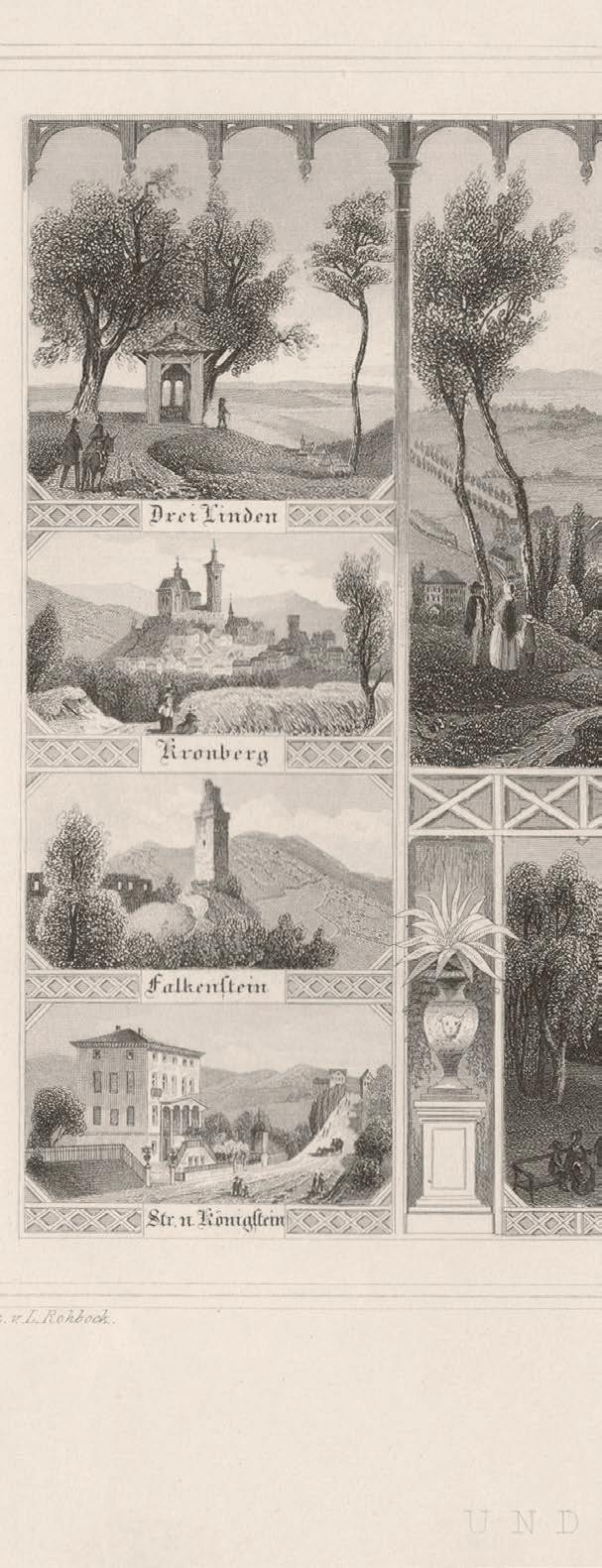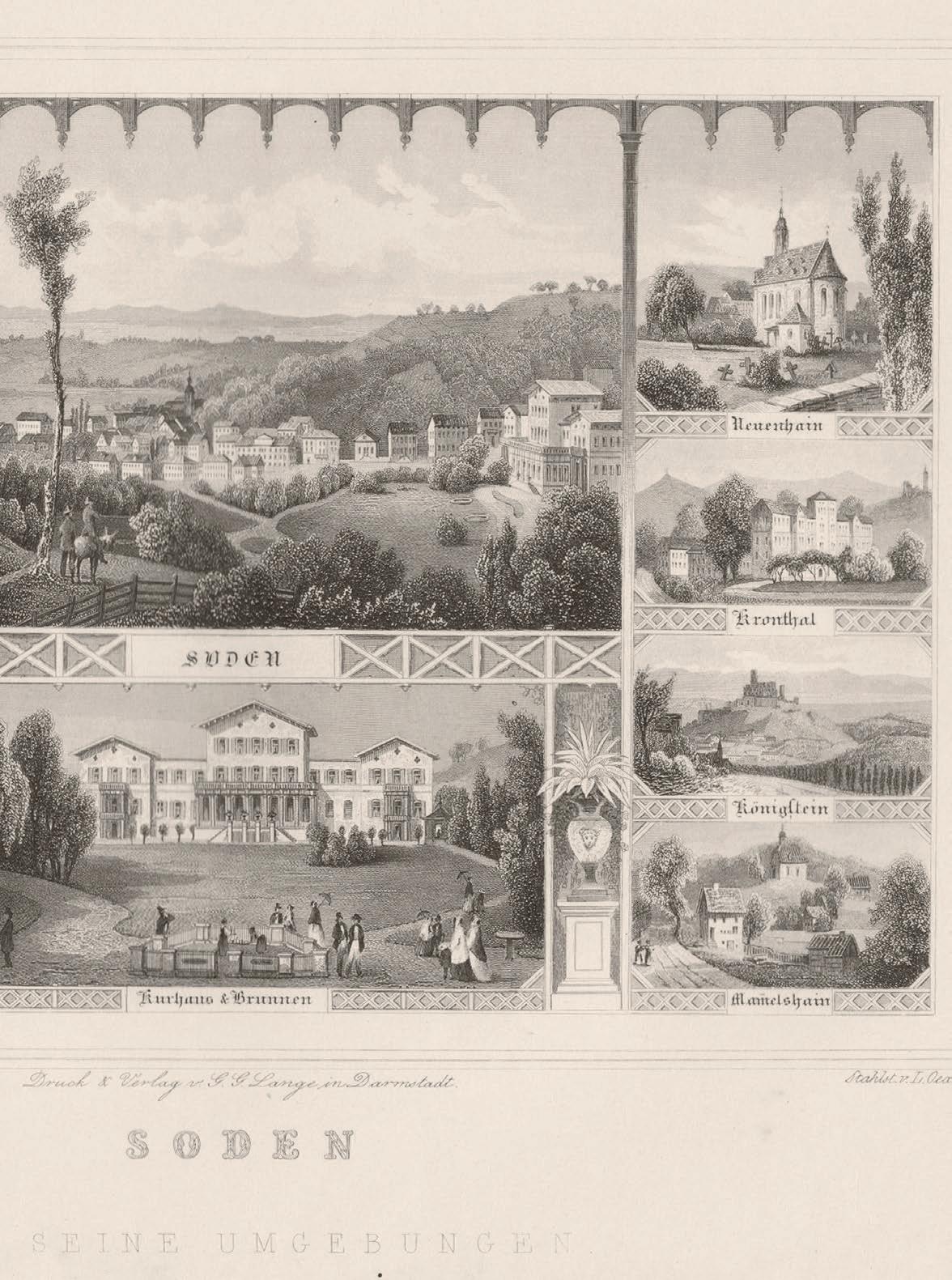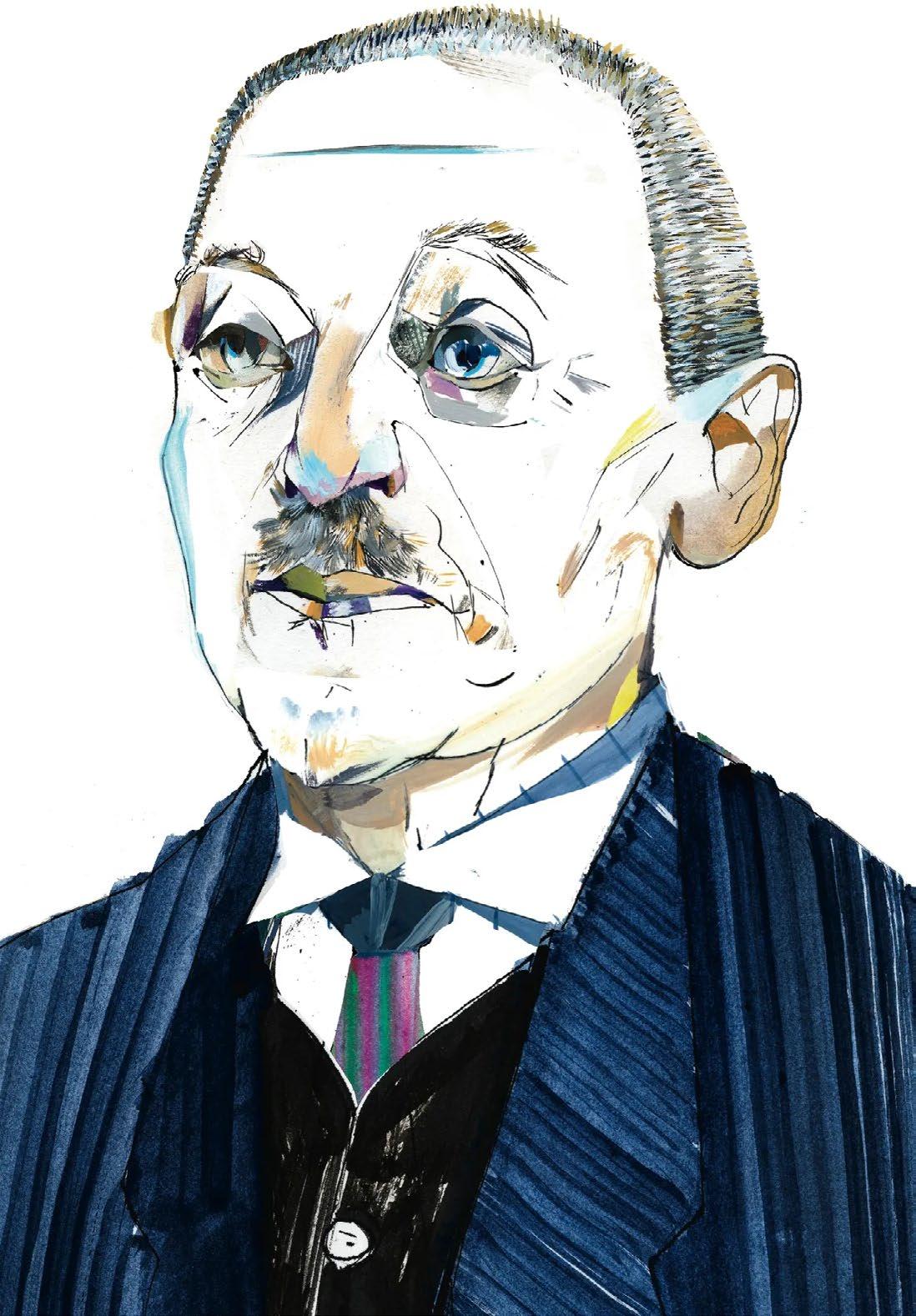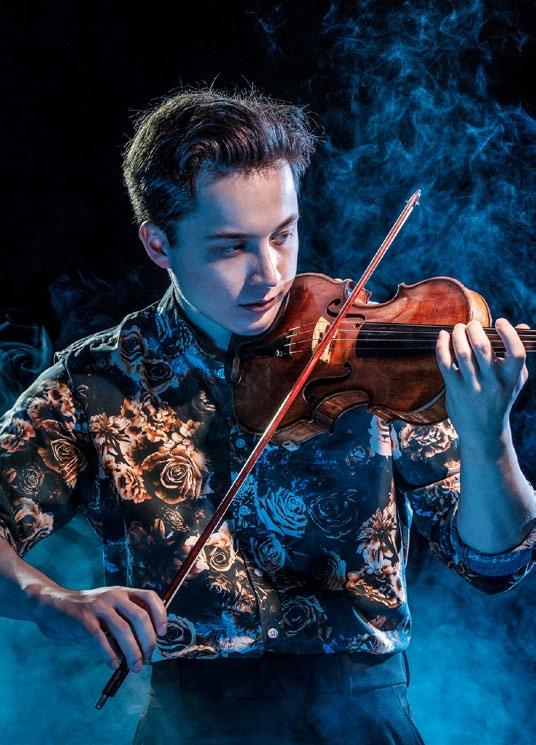

PROGRAMME
conductor Jukka-Pekka Saraste violin Johan Dalene
Felix Mendelssohn-Bartholdy (1809-1847)
Violin Concerto in E minor, Opus 64 (1844)
• Allegro molto appassionato
• Andante
• Allegretto non troppo - Allegro molto vivace
intermission
Anton Bruckner (1824-1896)
Symphony No. 7 in E major (1881–83)
• Allegro moderato
• Adagio. Sehr feierlich und sehr langsam
• Scherzo. Sehr schnell
• Finale. Bewegt, doch nicht schnell
Concert ends at around 22.15/16.15
Most recent performances by our orchestra:
Mendelssohn Violin Concerto: Mar 2021, violin Leonidas Kavakos, conductor Andrés Orozco Estrada (online)
Bruckner Symphony No. 7: Oct 2018, conductor Lahav Shani
One hour before the start of the concert, Wim Ruitenbeek and Galahad Samson will give an introduction (in Dutch) to the programme, admission €5. Tickets are available at the hall, payment by debit card. The introduction is free for Vrienden.
Cover: Photo Richard Dacker (Pexels).

 Bad Soden and surroundings. Engraving after a design by Ludwig Rohbock, c. 1850. Coll. Zentralinstitut für Kunstgeschichte, Munich.
Bad Soden and surroundings. Engraving after a design by Ludwig Rohbock, c. 1850. Coll. Zentralinstitut für Kunstgeschichte, Munich.
Happiness and Pain
Felix Mendelssohn’s Violin Concerto mirrors the idyllic circumstances in which the work was composed. There could hardly be a greater contrast with Anton Bruckner’s Seventh Symphony which depicts the grieving over a bitter loss.
Lustrous pearl
Mendelssohn lived a hectic, overworked and stressful life leading to an untimely death at just 38 years old. But the circumstances in which he wrote his Violin Concerto were –exceptionally – an oasis of calm. ‘I sit under apple trees and great oaks... In the afternoons and evenings I eat strawberries with my coffee, drink Assmannshäuser mineral water, rise at six in the morning, and still manage nine and half hours sleep.’ Following an exhausting concert tour, Mendelssohn was holidaying in Bad Soden, a beautiful location at the foot of the Taunus Mountains in central Germany. He had so much looked forward to leaving the commotion of the big city behind: ‘The first step out of Berlin is the first step to happiness.’ And he found that happiness here, together with his wife Cécile and their four young children. These were the perfect conditions in which to complete the piece that he had long been working on.
‘I want to write a concerto for you’, he had told his friend, violinist Ferdinand David, six years earlier. ‘A piece in E minor is racing through my mind and the introduction is not giving me a moment’s rest.’ But it just came
to nothing – perhaps because Mendelssohn had originally wanted to develop his ideas into a piano concerto, the manuscript for which surfaced only recently. The fact that this composition remained unfinished was perhaps a blessing in disguise, because otherwise we may never have been given the beautiful, lustrous pearl that is his Violin Concerto. Besides being beautiful, the work is also radical. Mendelssohn was the first composer to link the three movements of a concerto to each other: to avoid applause at the end of each movement, he would later explain. The first and second movements are connected by a sustained note on the bassoon; the second and third by a miniature movement, a lovely Allegretto that is reminiscent of the first movement. Another novelty is the cadenza, for which Mendelssohn wrote out each and every note, leaving no opportunity for the soloist to improvise.
Solemn hymn
Anton Bruckner was a great improvisor at the biggest organs. His magnificent symphonies were true cathedrals of music. He would set the brass section ablaze like no other. And yet Bruckner suffered terrible self-doubt. Till late in life he would seek out the opinions of teachers of musical theory, almost begging to be awarded the diplomas that could attest to his ability. Were a conductor to offer any comment about any of his symphonies, he would immediately revise the work. There is so much that is magisterial about Bruckner, yet so much that shows humility: his character will always remain a mystery.
 Anton Bruckner. Partrait by Riccardo Vecchio for The New Yorker.
Anton Bruckner. Partrait by Riccardo Vecchio for The New Yorker.
In July 1882 – he was by then aged 57 –Bruckner was permitted a visit to his idol, Richard Wagner. He showed his scores to Wagner, who expressed his admiration. Bruckner was on cloud nine.
Wagner: ‘I will conduct your symphonies.’
Bruckner: ‘Oh, Master!’
Wagner: ‘Have you seen the Parsifal? Did you like it?’
Bruckner: ‘Master, I adore you!’
Wagner: ‘Steady on, Bruckner. Now I am going to bed.’
During this exchange Bruckner had fallen to his knees, pressed Wagner’s ‘illustrious hand’ to his lips and kissed it.
Bruckner: ‘Master, I adore you!’
Wagner: ‘Steady on, Bruckner.
Now I am going to bed.’
Just half a year following this meeting, Wagner died. Bruckner was in deep shock. In his Seventh Symphony, which he had been working on for the previous one and a half years, he dedicated an important place for Wagner. He reworked the Adagio. It would become an elegy and hymn of praise to his great hero, ‘a very solemn and very slow’ movement that many consider to be the highpoint of his body of work. Bruckner expanded the orchestra with four so-called ‘Wagner tubas’, instruments deployed by Wagner in his opera cycle The Ring of the Nibelung. And then comes a clash of the cymbals during the climax of this slow movement. The story goes that Bruckner added this at the moment he heard of Wagner’s death. But that is pure myth: in fact the cymbal clash was a suggestion by the young, talented and daring conductor Arthur Nikisch, who would conduct the first performance.
Premonitory dream
The premiere of his Seventh Symphony would be Bruckner’s first great success; a triumph that had been predicted in a strange dream that came to him when he started working on the symphony. ‘A former friend from Linz, called Dorn, appeared before me. He dictated to me the main theme of the first movement, and I immediately wrote it down. “Take note,” said Dorn, “This theme will bring you luck.”’ It was about time, too. Till then, people had largely ignored Bruckner. But now the dream had become a premonition. Within days of the Leipzig premiere on 30 December 1884 the newspaper Deutsche Zeitung reported: ‘With mounting interest, the public followed the unfolding of the grandiose and deeply serious thoughts captured in this work. From one movement to the next the expressions of enthusiasm grew.’
This was in the city of Leipzig where, forty years previously, Mendelssohn’s Violin Concerto was also premiered. From this good start, success continued. Following its second performance on 10 March 1885 in the Odeon concert hall in Munich, conductor Hermann Levi gathered the members of the orchestra together once more. ‘Gentlemen! In this hall we have often played masterpieces before the King. Now we have a prince in the realm of music amongst us. I ask that in his honour you play once more a part of the Adagio.’ The auditorium had already emptied and the passage that expresses Bruckner’s pain at the death of Wagner was played three times in the now sanctified space. Eleven years later the same music would be played at Bruckner’s own funeral.
Stephen Westra
Johan Dalene • violin
Born: Svärtinge, Sweden
Education: first violin lessons at age four, student in residence Verbier Festival with Janine Jansen, Leif Ove Andsnes and Gideon Kremer, Stockholm Conservatory with Per Enoksson
Award: Gramophone Young Artist of the Year 2022
Breakthrough: 2019: First Prize International Carl Nielsen Competition
Subsequently: Gewandhausorchester Leipzig, Czech Philharmonic Orchestra, San Francisco Symphony Orchestra, London Philharmonic Orchestra, Royal Stockholm Philharmonic with conductors such as Semyon Bychkov, Andrew Manze, Sakari Oramo, Esa-Pekka Salonen; BBC New Generation Artist (2019–2021), artist in residence with the Swedish Radio Symphony Orchestra (2020–2021), Gävle Symphony (2023–2024) and the Royal Liverpool Philharmonic Orchestra (2023–2024)
Debut Rotterdam Philharmonic: 2024
Jukka-Pekka Saraste
• conductor
Born: Heinola, Finland
Current position: Music Director Helsinki Philharmonic Orchestra, Honorary Conductor Oslo Philharmonic Orchestra and Finnish Radio Symphony Orchestra; founder and Artistic Advisor Finnish Chamber Orchestra
Previously: Principal Conductor WDR Symphony Orchestra Cologne, Scottish Chamber Orchestra, Toronto Symphony Orchestra
Awards: Pro Finlandia Prize, Sibelius Medal, Finnish State Prize for Music
Guest Appearances: London Philharmonic Orchestra, Philharmonia Orchestra, Orchestre de Paris, Gewandhausorchester Leipzig, Royal Concertgebouw Orchestra, NHK Symphony Orchestra, Bavarian Radio Symphony, Munich
Philharmonic, Vienna Symphony, Staatskapelle Dresden, Cleveland Orchestra, symphony orchestras of Boston, Chicago, San Francisco, Los Angeles Philharmonic Orchestra, New York
Philharmonic Orchestra
Debut Rotterdam Philharmonic: 1990
 Photo: Felix Broede
Photo: Mats Bäcker
Photo: Felix Broede
Photo: Mats Bäcker
Agenda
Proms: Spring Is In The Air
Fri 19 April 2024 • 20.30
leader Marieke Blankestijn
violin Kira van der Woerd
Vivaldi The Four Seasons: Spring
Pachelbel Canon and Gigue
Handel Concerto Grosso Op.6
No.4
Bach Air from Suite No. 3
Vivaldi The Four Seasons: Summer
Fri 26 April 2024 • 18.00
conductor Yannick Nézet-Séguin
Siegmund Stanislas de Barbeyrac
Sieglinde Elza van den Heever
Hunding Soloman Howard
Wotan Brian Mulligan
Brünnhilde Tamara Wilson
Fricka Karen Cargill
Wagner Die Walküre
Thu 2 May 2024 • 20.15
conductor Yannick Nézet-Séguin
violin Randall Goosby
Dvořák Overture Carnival
Price Violin Concerto No. 2
Price Adoration
Brahms Symphony No. 4
Commemoration Concert
Tue 14 May 2024 • 20.15
Rotterdam, Laurenskerk
conductor Giuseppe Mengoli
soprano Ilse Eerens
choir Laurens Collegium
Lutosławski Musique funèbre
Bruckner Ave Maria
Bruckner Aequale Nos. 1 and 2
Bruckner Christus factus est
Schönberg Friede auf Erden
Vivaldi Gloria
Chief Conductor
Lahav Shani
Honorary Conductor
Musicians
Viola
Anne Huser
Roman Spitzer
Galahad Samson
José Moura Nunes
Yannick Nézet-Séguin
Principal Guest Conductor
Tarmo Peltokoski
First Violin
Marieke Blankestijn, concertmeester
Quirine Scheffers
Hed Yaron Meyerson
Saskia Otto
Arno Bons
Mireille van der Wart
Rachel Browne
Maria Dingjan
Marie-José Schrijner
Noëmi Bodden
Petra Visser
Sophia Torrenga
Hadewijch Hofland
Annerien Stuker
Alexandra van Beveren
Second Violin
Charlotte Potgieter
Cecilia Ziano
Frank de Groot
Laurens van Vliet
Tomoko Hara
Elina Staphorsius
Jun Yi Dou
Bob Bruyn
Eefje Habraken
Maija Reinikainen
Wim Ruitenbeek
Babette van den Berg
Melanie Broers
Lana Trimmer
Kerstin Bonk
Lex Prummel
Janine Baller
Francis Saunders
Veronika Lénártová
Rosalinde Kluck
León van den Berg
Olfje van der Klein
Cello
Emanuele Silvestri
Eugene Lifschitz
Joanna Pachucka
Daniel Petrovitsch
Mario Rio
Gé van Leeuwen
Eelco Beinema
Carla Schrijner
Pepijn Meeuws
Yi-Ting Fang
Double Bass
Matthew Midgley
Ying Lai Green
Jonathan Focquaert
Robert Franenberg
Harke Wiersma
Arjen Leendertz
Ricardo Neto
Flute
Juliette Hurel
Joséphine Olech
Flute/piccolo
Beatriz Da Baião
Oboe
Remco de Vries
Karel Schoofs
Anja van der Maten
Oboe/Cor Anglais
Ron Tijhuis
Clarinet
Julien Hervé
Bruno Bonansea
Clarinet/ Bass Clarinet
Romke-Jan Wijmenga
Bassoon
Pieter Nuytten
Lola Descours
Marianne Prommel
Bassoon/ Contrabassoon
Hans Wisse
Horn
David Fernández Alonso
Felipe Santos Freitas Silva
Wendy Leliveld
Richard Speetjens
Laurens Otto
Pierre Buizer
Trumpet
Alex Elia
Simon Wierenga
Jos Verspagen
Trombone
Pierre Volders
Alexander Verbeek
Remko de Jager
Bass trombone
Rommert Groenhof
Tuba
Hendrik-Jan Renes
Percussion
Danny van de Wal
Ronald Ent
Martijn Boom
Adriaan Feyaerts
Harp
Charlotte Sprenkels
